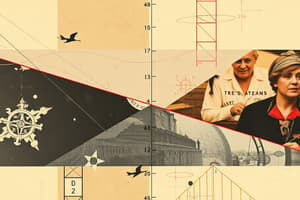Podcast
Questions and Answers
A line segment has endpoints at (2, -3) and (-4, 5). What is the midpoint of this line segment?
A line segment has endpoints at (2, -3) and (-4, 5). What is the midpoint of this line segment?
- (3, -4)
- (-1, 1) (correct)
- (1, -1)
- (-2, 2)
What is the slope of a line perpendicular to a line with a slope of $ -\frac{3}{4}$?
What is the slope of a line perpendicular to a line with a slope of $ -\frac{3}{4}$?
- $-\frac{4}{3}$
- $\frac{4}{3}$ (correct)
- $\frac{3}{4}$
- $-\frac{3}{4}$
A circle in the coordinate plane has a center at (3, -2) and a radius of 4. Which of the following represents the equation of the circle?
A circle in the coordinate plane has a center at (3, -2) and a radius of 4. Which of the following represents the equation of the circle?
- $(x + 3)^2 + (y - 2)^2 = 16$
- $(x - 3)^2 + (y + 2)^2 = 16$ (correct)
- $(x - 3)^2 + (y + 2)^2 = 4$
- $(x + 3)^2 + (y - 2)^2 = 4$
Which of the following describes the solution set for a system of two linear equations that are graphed as two parallel lines?
Which of the following describes the solution set for a system of two linear equations that are graphed as two parallel lines?
What is the next term in the geometric sequence: 3, 6, 12, 24, ...?
What is the next term in the geometric sequence: 3, 6, 12, 24, ...?
If a sequence is defined by the recursive formula $a_n = 2a_{n-1} + 1$ with $a_1 = 3$, what is the value of $a_3$?
If a sequence is defined by the recursive formula $a_n = 2a_{n-1} + 1$ with $a_1 = 3$, what is the value of $a_3$?
Which of the following is the standard form of a line with slope of $2$ passing through the point $(-1, 3)$?
Which of the following is the standard form of a line with slope of $2$ passing through the point $(-1, 3)$?
A parabola has a vertex at $(2, -1)$ and passes through the point $(3, 1)$. Assuming it opens upward, what is the value of ‘a’ in the equation: $(y - k) = a(x - h)^2$ ?
A parabola has a vertex at $(2, -1)$ and passes through the point $(3, 1)$. Assuming it opens upward, what is the value of ‘a’ in the equation: $(y - k) = a(x - h)^2$ ?
For the system of equations: $x + y = 5$ and $x - y = 1$, what are the values for $x$ and $y$?
For the system of equations: $x + y = 5$ and $x - y = 1$, what are the values for $x$ and $y$?
What is the distance between the points (-2, 3) and (4, -5) in a Cartesian plane?
What is the distance between the points (-2, 3) and (4, -5) in a Cartesian plane?
What is the nth term formula for an arithmetic sequence?
What is the nth term formula for an arithmetic sequence?
Which formula correctly calculates the sum of a finite geometric series?
Which formula correctly calculates the sum of a finite geometric series?
In a Fibonacci sequence, what is the correct definition of the terms?
In a Fibonacci sequence, what is the correct definition of the terms?
How can the sum of an arithmetic series be expressed mathematically?
How can the sum of an arithmetic series be expressed mathematically?
Which statement about recurrence relations is true?
Which statement about recurrence relations is true?
What does the variable 'd' represent in the formula for the nth term of an arithmetic sequence?
What does the variable 'd' represent in the formula for the nth term of an arithmetic sequence?
In the context of sequences, what is a common misconception about the geometric series?
In the context of sequences, what is a common misconception about the geometric series?
What defines a geometric sequence?
What defines a geometric sequence?
Which is NOT a characteristic of arithmetic sequences?
Which is NOT a characteristic of arithmetic sequences?
Flashcards
Arithmetic Sequence Formula
Arithmetic Sequence Formula
The formula for finding the nth term is an = a₁ + (n-1)d.
Geometric Sequence Formula
Geometric Sequence Formula
The nth term can be found using an = a₁ * r^(n-1).
Series
Series
A series is the sum of terms in a sequence.
Arithmetic Series Sum Formula
Arithmetic Series Sum Formula
Signup and view all the flashcards
Geometric Series Sum Formula
Geometric Series Sum Formula
Signup and view all the flashcards
Recurrence Relations
Recurrence Relations
Signup and view all the flashcards
Fibonacci Sequence
Fibonacci Sequence
Signup and view all the flashcards
Common Difference
Common Difference
Signup and view all the flashcards
Common Ratio
Common Ratio
Signup and view all the flashcards
Importance of Sequences
Importance of Sequences
Signup and view all the flashcards
Coordinate Geometry
Coordinate Geometry
Signup and view all the flashcards
Ordered Pair
Ordered Pair
Signup and view all the flashcards
Distance Formula
Distance Formula
Signup and view all the flashcards
Midpoint Formula
Midpoint Formula
Signup and view all the flashcards
Slope of a Line
Slope of a Line
Signup and view all the flashcards
Parallel Lines
Parallel Lines
Signup and view all the flashcards
Perpendicular Lines
Perpendicular Lines
Signup and view all the flashcards
Conic Sections
Conic Sections
Signup and view all the flashcards
Simultaneous Equations
Simultaneous Equations
Signup and view all the flashcards
Arithmetic Sequence
Arithmetic Sequence
Signup and view all the flashcards
Geometric Sequence
Geometric Sequence
Signup and view all the flashcards
Study Notes
Coordinate Geometry
- Coordinate geometry deals with geometric figures in a coordinate plane (typically the Cartesian plane).
- Points are represented by ordered pairs (x, y) where x is the horizontal coordinate (abscissa) and y is the vertical coordinate (ordinate).
- The distance between two points (x₁, y₁) and (x₂, y₂) is given by the distance formula: √((x₂ - x₁)² + (y₂ - y₁)²).
- The midpoint of a line segment with endpoints (x₁, y₁) and (x₂, y₂) is ((x₁ + x₂)/2, (y₁ + y₂)/2).
- The slope of a line passing through two points (x₁, y₁) and (x₂, y₂) is given by (y₂ - y₁)/(x₂ - x₁).
- Parallel lines have the same slope.
- Perpendicular lines have slopes that are negative reciprocals of each other.
- Equations of lines can be written in various forms, including point-slope form, slope-intercept form (y = mx + b), and standard form (Ax + By = C).
- The equation of a circle with center (h, k) and radius r is (x - h)² + (y - k)² = r².
- The equation of a parabola with vertex (h, k) opens upward is (y - k) = a(x - h)² + c.
- Different conic sections (circles, ellipses, parabolas, hyperbolas) have specific equations that can be graphed and analyzed using coordinate geometry principles.
Simultaneous Equations
- Simultaneous equations are a set of two or more equations with the same variables.
- The goal is to find the values of the variables that satisfy all the equations simultaneously.
- Methods for solving simultaneous equations include:
- Substitution: Solve one equation for one variable, and substitute the expression into the other equation.
- Elimination: Add or subtract the equations to eliminate one variable.
- Graphical Method: Graph the equations and find the point(s) of intersection.
- Linear simultaneous equations (with variables raised to the power of 1) often have a single unique solution, no solution (parallel lines), or infinitely many solutions (the same line).
- Non-linear simultaneous equations (variables raised to a power other than 1) can have more than one solution.
- The solution to a system of equations represents a point that lies on all lines in the system.
Sequences
- A sequence is an ordered list of numbers.
- The numbers in a sequence are called terms.
- Sequences can be arithmetic, geometric, or neither.
- Arithmetic sequences have a constant difference between consecutive terms (common difference).
- Geometric sequences have a constant ratio between consecutive terms (common ratio).
- The nth term of an arithmetic sequence can be found using the formula: an = a₁ + (n-1)d, where a₁ is the first term and d is the common difference.
- The nth term of a geometric sequence can be found using the formula: an = a₁ * r^(n-1), where a₁ is the first term and r is the common ratio.
- Series are the sum of the terms in a sequence.
- The sum of an arithmetic series can be calculated using the formula: Sn = n/2 (2a₁ + (n-1)d).
- The sum of a finite geometric series can be calculated using the formula: Sn = a₁ (1 - r^n) / (1 - r), where r ≠ 1.
- Recurrence relations define terms in a sequence based on previous terms in the sequence.
- Special types of sequences include Fibonacci sequences, where each term is the sum of the two preceding terms.
- Understanding sequences is valuable in many areas of mathematics and beyond, helping model patterns and behavior in various applications.
Studying That Suits You
Use AI to generate personalized quizzes and flashcards to suit your learning preferences.




